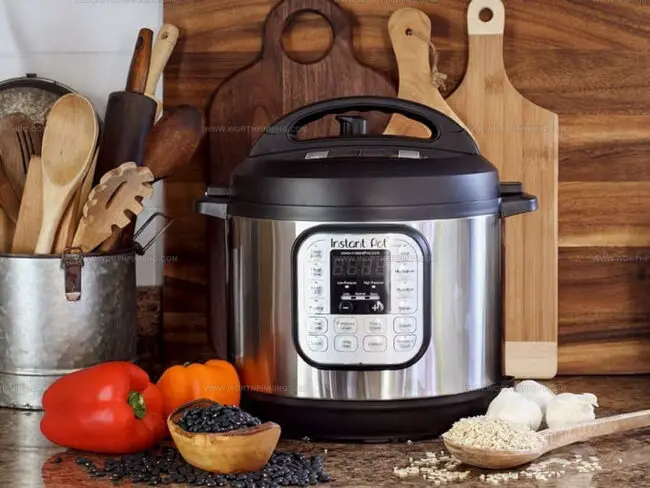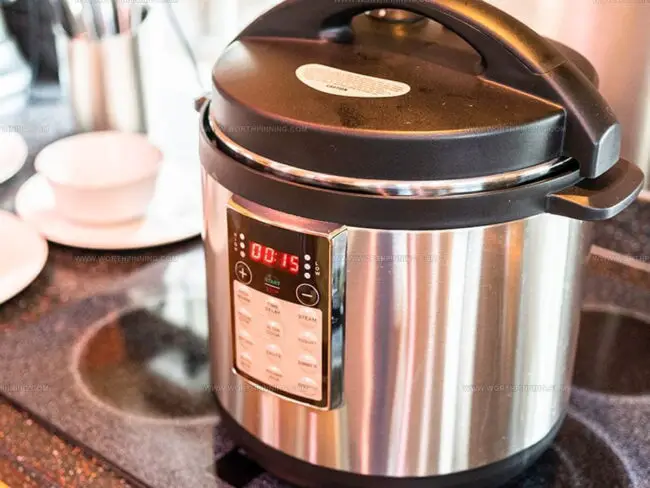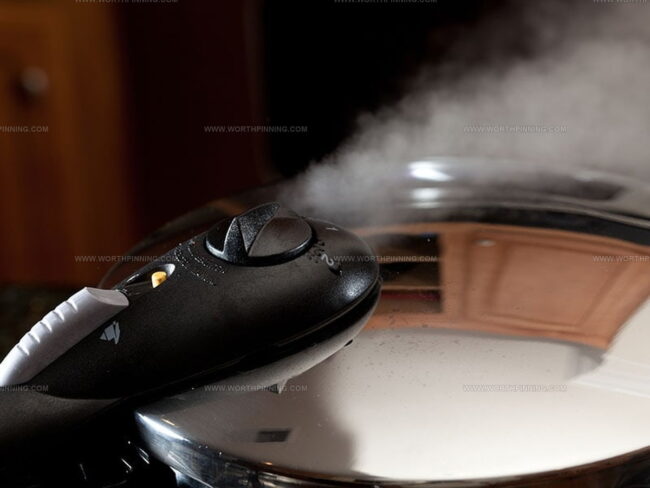Pressure Cooker or Air Fryer: Fast Cooking Face-Off
Pressure cookers have revolutionized kitchen efficiency for busy home cooks everywhere.
Time-saving appliances lock in flavors while reducing cooking times dramatically.
Most modern models come equipped with multiple safety features that eliminate concerns from previous generations.
Meanwhile, air fryers offer a healthier alternative to traditional deep frying with significantly less oil.
The crispy texture they create rivals conventional methods without the extra calories or mess.
Both machines serve different purposes in meal preparation, though many households now own both for maximum versatility.
You deserve kitchen tools that make delicious meals easier and faster to prepare.
Ready to find out which appliance might better suit your cooking style and favorite recipes?
Pressure Cooker: What Is It and How It Work?
A pressure cooker is a sealed pot that cooks food faster by trapping steam from a small amount of liquid (water, broth, etc.), which raises the internal temperature above boiling; typically up to about 250°F (121°C), and creates high pressure.
The buildup of steam increases the boiling point and forces moisture into the food, tenderizing it quickly and reducing cooking time compared to conventional methods.
When cooking is done, the pressure must be released safely, either naturally or via a quick-release valve, before opening.
Electric models like Instant Pots are essentially electric pressure cookers with added programmable functions (timers, sauté, slow-cook, etc.), making them more versatile and user-friendly, but the core cooking principle - sealed high-pressure steam, is the same.
Pros and Cons of Pressure Cooker
Pros:
Cons:
Air Fryer: Overview
An air fryer is a compact countertop appliance that cooks food by circulating very hot air to create a crispy exterior with little to no oil.
It heats quickly (often up to about 392°F / 200°C) and forces air around the food, browning and crisping via the Maillard reaction without deep-frying.
Because of the rapid, even heat and built-in timer/temperature controls, it’s easy to set and forget, reducing the risk of under- or overcooking.
Its small chamber shortens cook times compared to full-size ovens, making it especially convenient for busy cooks who want fried-like texture with fewer calories and less mess.
Pros and Cons of Air Fryer
Pros:
Cons:
The Similarities Between Pressure Cooker And Air Fryer
Pressure cooker and air fryer share several similarities, such as:
Pressure Cooker vs Air Fryer: Finding Their Differences
Making a decision between a pressure cooker and air fryer gets easier when you understand how they stack up against each other. Check this table for a perfect overview about their differences.
| Category | Pressure Cooker | Air Fryer |
| Idea Foods to Cook | Soups, stews, rice, grains, oatmeal, whole chicken, meats, fish, vegetables (especially braised or liquid-based) | Fried chicken, fries/chips, crispy vegetables, breakfast items, small proteins (chicken tenders, fish), reheating |
| Cooking method with Result | Sealed high-pressure steam: yields tender, moist, juicy food; good for combining ingredients in one pot | Rapid hot air circulation: produces crispy, browned exterior with drier interior; mimics frying with little/no oil |
| Cost | Generally higher upfront (especially premium brands like Breville); mid-tier options exist (e.g., Presto) | Usually more affordable; many reliable brands (Philips, Cosori, Ninja) |
| Size & Capacity | Larger capacity (common 6 qt household; some up to 35–40 qt) but inefficient for very small amounts; less portable | Smaller (3–8 qt typical, some up to 12 qt); easy to move/bring on trips; better for small-to-medium batches |
| Performance | Faster than traditional stovetop/oven for wet dishes, but needs time to build pressure first | Very fast due to direct hot air circulation; often seems quicker in actual cook time for many foods |
| Energy Use | More efficient overall (shorter effective energy consumption) | Uses more electricity per session, especially for “fried” results |
| Health angle | Retains nutrients by shortening cook time; not focused on fat reduction (depends on ingredients) | Lowers fat/calorie content by using little to no oil; ideal for weight-conscious diets and keto |
| Safety considerations | Sealing gasket integrity critical—leaks or damage can cause steam burns; pressure release must be handled correctly | Exterior and internal surfaces get very hot; risk of burns when removing food or touching housing |
| Cleaning / maintenance | More parts to clean (lid components, gasket, inner pot); requires disassembly for thorough cleaning | Simpler: removable basket/pot, usually just wipe or rinse; less maintenance |
Types of Foods
Pressure cookers excel with moist, liquid-based dishes - soups, stews, rice, grains, oatmeal, whole poultry, tougher cuts of meat, fish, and vegetables, because they combine and tenderize ingredients quickly under steam.
Air fryers shine with foods that benefit from a crispy exterior: fried-style chicken, fries/chips, breakfast items, small cuts (tenders, fish fillets), and reheating previously cooked items; they can handle veggies and even some “baked” goods but aren’t ideal for soups or one-pot braises.
Cooking Method & Result
A pressure cooker traps steam to raise temperature and pressure, softening and infusing foods so they come out tender, moist, and well-blended, often allowing multiple components to cook together.
An air fryer circulates superheated air around food, creating a Maillard-driven crust and golden browning with minimal oil; the interior tends to be drier and firmer, giving a fried texture without submerging in fat.
Cost
Pressure cookers generally have higher entry prices, especially electric models with multi-functionality (e.g., programmable brands like Breville or Instant Pot alternatives), but mid-tier options exist.
Air fryers are typically more affordable across a wide range of brands (Ninja, Cosori, Philips), making crispy “fried” results accessible; premium models with larger capacity or smart features can narrow the price gap.
Size & Capacity
Pressure cookers usually offer larger capacity (common household size 6 quarts, with some commercial-style ones 35–40 quarts) but become inefficient with very small batches, and their bulk limits portability.
Air fryers are smaller (3–8 quarts typical, some up to 12), better suited for small-to-medium families, and easy to carry for picnics or travel; they heat faster and waste less space for single or dual servings.
Performance
Air fryers often feel quicker for items needing crisping because they start delivering direct heat immediately. Pressure cookers require ramp-up time to build pressure, after which they rapidly finish dense or tough foods, making them unbeatable for beans, stews, and whole proteins, whereas air fryers outpace for quick searing and surface browning.
Energy Use
Pressure cookers tend to be more energy-efficient overall because they complete hearty dishes in a short, high-pressure burst with minimal heat loss.
Air fryers consume more electricity per session relative to the amount of food crisped, especially when used for “fried” textures, since they rely on sustained high temperatures and circulating fans for browning.
Nutrition
Air fryers are ideal for reducing fat intake since they achieve crispy results with little to no oil, making them favorites for calorie-conscious, keto, or heart-healthy cooking.
Pressure cookers preserve nutrients by minimizing cook time and exposure to high heat and moisture loss, making them excellent for retaining vitamins in soups, vegetables, and lean proteins; they don’t inherently reduce fat unless you choose lean ingredients.
Safety
Modern pressure cookers are safe when used correctly, but attention is needed on seals, valves, and proper pressure release, faulty gaskets or improper venting can cause dangerous steam burns.
Air fryers have a lower risk of catastrophic failure, but their exteriors and interiors get very hot; users must handle baskets carefully to avoid burns and allow proper cooling before cleaning.
Cleaning & Maintenance:
Air fryers typically require less upkeep: removable baskets/pans are often nonstick and dishwasher-safe, and the unit seldom needs disassembly.
Pressure cookers demand more thorough cleaning. Lids must be taken apart to clean gaskets, valves, and sealing rings to avoid trapped residue or odors, and the inner pot needs routine inspection to ensure continued safe pressure buildup.
What are Cautions in Using Pressure Cooker and Air Fryer?
Here are the key cautions to keep in mind so you can use them effectively and avoid burns, malfunctions, or degraded results.
Keep in mind, you must always follow manufacturer instructions for safe operation.
For Pressure Cooker
For Air Fryer
Got Questions? We’ve Got Solutions
1. Can I make crispy foods in a pressure cooker?
Pressure cookers can't make foods crispy as they cook with moist heat. For crispy textures, air fryers are better as they circulate hot air to create that golden, crunchy exterior on foods like french fries and chicken wings.
2. Which one cooks faster - pressure cooker or air fryer?
Pressure cookers typically cook faster than air fryers. They can prepare stews, beans, and tough cuts of meat in a fraction of the time. An air fryer might take longer but provides that desirable crispy texture that pressure cookers can't achieve.
3. Which is easier to clean?
Air fryers are usually easier to clean as they have fewer parts. Most air fryer baskets are dishwasher-safe. Pressure cookers have more components like sealing rings and pressure valves that require careful cleaning to maintain proper function.
4. Can I convert recipes between these appliances?
Not all recipes work in both appliances. Pressure cookers excel at soups, stews, and braised meats, while air fryers are best for foods you'd typically bake, fry, or roast. The cooking methods are fundamentally different, so recipes usually need significant adjustments.







Sophia Rivera
Recipe Developer & Kitchen Tips Specialist
Expertise
Education
Austin Community College
San Antonio Culinary Institute
Sophia’s passion for baking began in her family kitchen, where she spent hours experimenting with new recipes. With a background in baking and pastry arts, she loves making desserts that are as visually stunning as they are delicious.
Sophia is all about using seasonal, locally sourced ingredients to create treats that everyone will enjoy. When she’s not creating mouth-watering desserts, you can find her gardening, making new recipes, or enjoying a relaxing afternoon with her family.